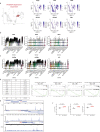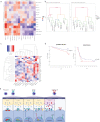Single-cell analysis identifies dynamic gene expression networks that govern B cell development and transformation
- PMID: 34824268
- PMCID: PMC8617197
- DOI: 10.1038/s41467-021-27232-5
Single-cell analysis identifies dynamic gene expression networks that govern B cell development and transformation
Abstract
Integration of external signals and B-lymphoid transcription factor activities organise B cell lineage commitment through alternating cycles of proliferation and differentiation, producing a diverse repertoire of mature B cells. We use single-cell transcriptomics/proteomics to identify differentially expressed gene networks across B cell development and correlate these networks with subtypes of B cell leukemia. Here we show unique transcriptional signatures that refine the pre-B cell expansion stages into pre-BCR-dependent and pre-BCR-independent proliferative phases. These changes correlate with reciprocal changes in expression of the transcription factor EBF1 and the RNA binding protein YBX3, that are defining features of the pre-BCR-dependent stage. Using pseudotime analysis, we further characterize the expression kinetics of different biological modalities across B cell development, including transcription factors, cytokines, chemokines, and their associated receptors. Our findings demonstrate the underlying heterogeneity of developing B cells and characterise developmental nodes linked to B cell transformation.
© 2021. The Author(s).
Conflict of interest statement
The authors declare no competing interests.
Figures







References
-
- Rolink A, Grawunder U, Winkler TH, Karasuyama H, Melchers F. IL-2 receptor α chain (CD25JAC) expression defines a crucial stage in pre-B cell development. Int. Immunol. 1994;6:1257–1264. - PubMed
-
- Ghia P, Ten Boekel E, Rolink AG, Melchers F. B-cell development: a comparison between mouse and man. Immunol. Today. 1998;19:480–485. - PubMed
-
- Nutt SL, Heavey B, Rolink AG, Busslinger M. Commitment to the B-lymphoid lineage depends on the transcription factor Pax5. Nature. 1999;401:556–562. - PubMed
Publication types
MeSH terms
Substances
Grants and funding
- R01AI147540/U.S. Department of Health & Human Services | NIH | National Institute of Allergy and Infectious Diseases (NIAID)
- R01CA232317/U.S. Department of Health & Human Services | NIH | National Cancer Institute (NCI)
- R01AI124512/U.S. Department of Health & Human Services | NIH | National Institute of Allergy and Infectious Diseases (NIAID)
- R01 AI147540/AI/NIAID NIH HHS/United States
- R01 CA232317/CA/NCI NIH HHS/United States
LinkOut - more resources
Full Text Sources
Molecular Biology Databases
Miscellaneous

